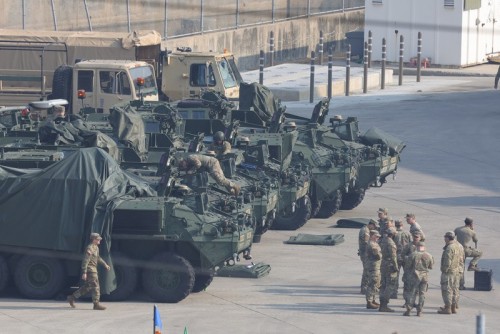 |
| U.S. Forces Korea troops stand alongside Stryker armored vehicles. / Source: Yonhap News |
The administration of U.S. President Donald Trump is considering a plan to withdraw thousands of American troops from South Korea, according to a Wall Street Journal (WSJ) report on April 22 citing U.S. defense officials.
The Pentagon is reportedly drafting options to relocate about 4,500 of the roughly 28,500 American forces currently stationed in South Korea to other parts of the Indo-Pacific, including the U.S. territory of Guam.
According to officials, the proposal is part of an informal policy review on North Korea and is being prepared for Trump's potential consideration. However, the plan has not yet been presented to the president and remains one of several under discussion by senior administration officials.
In response to an inquiry from Yonhap News regarding the report, a Pentagon spokesperson said only, “We have no announcements to make today.”
Pete Nguyen, spokesperson for the National Security Council (NSC), declined to comment on the troop withdrawal issue but told WSJ that President Trump remains committed to the complete denuclearization of North Korea.
The report also notes that no decision on troop levels is expected until there is greater clarity on the trajectory of the war in Ukraine and whether the Trump administration will continue military support for Kyiv.
WSJ noted that a serious U.S. move to reduce troop numbers in South Korea could unsettle regional allies such as Japan and the Philippines, who rely on close defense cooperation with the U.S.
In testimony before the Senate Armed Services Committee on April 10, U.S. Indo-Pacific Command chief Adm. Samuel Paparo and U.S. Forces Korea commander Gen. Xavier Brunson both warned that reducing American troop presence in South Korea would not only weaken deterrence against North Korea but also hinder the U.S. military’s ability to counter China and Russia in the region.
The U.S. military presence on the Korean Peninsula, the report emphasized, serves not just to deter conflict with North Korea but also to check China’s expanding claims in the South China Sea and growing threats toward Taiwan.
However, WSJ suggested that relocating troops to other Indo-Pacific hubs, such as Guam, could mitigate some of the Pentagon’s concerns about reduced deterrence. Guam, in particular, is seen as a strategic hub—close enough to potential conflict zones but still out of reach of most Chinese military assets.
The troop reduction consideration appears tied to the forthcoming U.S. National Defense Strategy (NDS), which Defense Secretary Pete Hegseth ordered to be drafted earlier this month. Hegseth’s guidance prioritizes defending the U.S. homeland, countering China in the Indo-Pacific, and increasing cost-sharing among global allies.
Elbridge Colby, the undersecretary of defense for policy overseeing the NDS process, has long advocated that while the U.S. should continue to offer extended deterrence (the nuclear umbrella) to protect South Korea from North Korean nuclear threats, Seoul should take more responsibility for conventional defense against the North.
Before taking office, Colby stated on social media that he does not support a full troop withdrawal from South Korea, but he does back a reorientation of U.S. forces to better counter China, while encouraging South Korea to play a greater role in defending against North Korea’s conventional forces.
Most Read
-
1
-
2
-
3
-
4
-
5
-
6
-
7





















